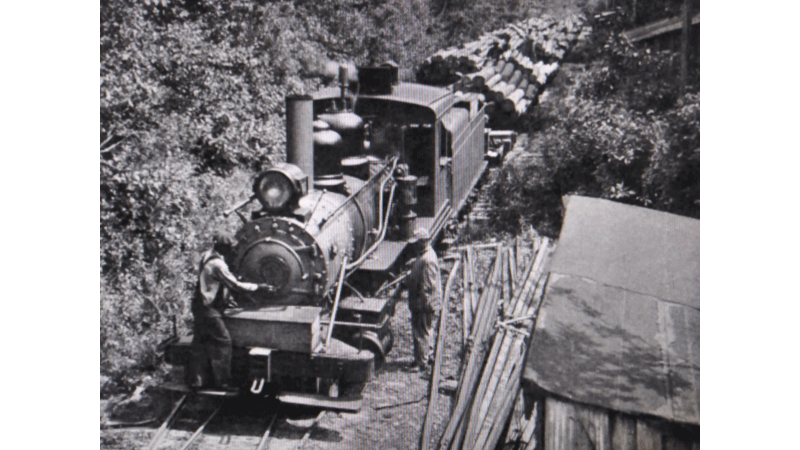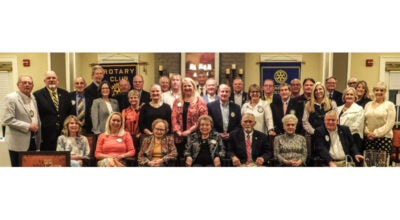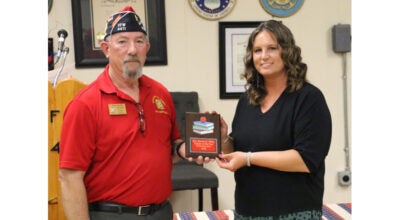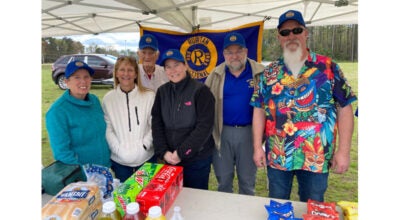LOOKING BACK: Camp Manufacturing Company and the Dismal Swamp
Published 7:15 pm Friday, June 3, 2022

- Camp Manufacturing Company built 59 miles of narrow-gauge railways to facilitate timber removal and make connections with the railroad at Suffolk. (Photo submitted by Clyde Parker)
|
Getting your Trinity Audio player ready...
|
During the last half of the 19th Century, the family headed by George Camp II of Southampton County, Va. and Sallie Cutchins Camp, originally from Isle of Wight County, Va., was at the forefront of logging and lumbering in southeastern Virginia. Married in 1837, George and Sallie Camp had 10 children: Mary Eliza Camp, John Stafford Camp, Joseph E. Camp, James E. Camp, William Nelson Camp, Paul Douglas Camp, Benjamin Franklin Camp, Sarah Virginia “Jenny” Camp, Robert Judson Camp, and James Leonidas Camp. The family resided on the huge Camp Farm located on the northern edge of “Franklin Depot” bordering the Blackwater River.
In 1887, two of the Camp brothers (James L. and Paul D.) purchased from the Neely Brothers a lumber mill that was located on the eastern side of the Blackwater River next to Franklin. That purchase turned out to be the establishment of Camp Manufacturing Co.; soon, brother Robert J. joined the company. And, at that time, Camp brothers William N., Benjamin F., and John S. were participating as shareholders. Earlier, during the period from the late 1860s well into the 1880s, the Camps had established several other lumber mills – along the Nottoway River, at Delaware and Monroe, and near Como in North Carolina; but, later, those mills were closed so they could concentrate on the Franklin Mill. However, a little later, the Camps changed their minds about adding more mill locations; in 1896, they purchased from John Arringdale a lumber mill at Drewryville and two year’s supply of timber – and, in 1902, they bought a large tract of timberland and built a lumber mill at Butterworth in Dinwiddie County.
The Camp brothers held great fascination for the Great Dismal Swamp – even though its western edge was about twenty miles east of Franklin, in Nansemond County. But, it was William Nelson Camp, the fifth child, who knew the swamp best. Fourteen years after his 1870 marriage to Texanna Gay of Windsor, in Isle of Wight County, he moved his family to Suffolk and started Gay Manufacturing Co., a lumber firm, with his father-in-law William H. “Pappy” Gay.
During the latter half of the 19th century and well into the early 1900s, the Camps bought quite a lot of timberland throughout southern Virginia and northeastern North Carolina. Of the tracts they bought, the most significant was 40,000 acres of the Dismal Swamp which William Nelson Camp negotiated in 1899, for $76,500, from successors to the Dismal Swamp Land Co. which was originally chartered in 1764 by George Washington.
Included in the purchased land – a rough rectangle which stretched from near Suffolk, in Nansemond County, eastward into Norfolk County, and southward to the North Carolina line – was Lake Drummond, a large but very shallow body of water that was surrounded by many and various kinds of huge and beautiful trees. The trees in those locations along with the many junipers, cedars and cypresses located throughout the entire swamp were what first attracted the Camps. Pine trees became highly desirable later.
During the early 1900s, in order to move timber out of the swamp and into the Franklin lumber mill, William Nelson Camp developed a procedure that involved floating logs into and up the Jericho Canal which extended from Lake Drummond northward to the headwaters of the Nansemond River in Suffolk.There, the timber was connected with the Portsmouth and Roanoke Railroad (later Seaboard Airline Railroad) which ran through Franklin. When it was determined, by a court decision, that his plan conflicted and interfered with the canal’s use by competitive Dismal Swamp based businesses, Camp Manufacturing Co. had to find other ways to remove and use their timber. So, they built 59-miles of narrow-gauge railways to facilitate timber removal and make connections with the railroad at Suffolk. During the late 1920s and 1930s, a lot of timber was transported using over-the-highway trucks.
In the 1920s, Camp Manufacturing Co. went to court over the Dismal Swamp. This was the second time going to court; this time, it was to resist a claim that their company had laid claim to a small tract owned by others. In order to defend the Camp family’s 1899 purchase, attorneys John Crafford Parker, of Franklin, and Toy Savage Sr., of Norfolk, searched George Washington’s original hand-written diaries, located in a New York archive, for details of Washington’s Dismal Swamp land-grant. The case was settled in favor of the Camps.
Over time, the original 40,000-acre William Nelson Camp purchase grew, through additional periodic acquisitions, to more than 49,000 acres.
During the late 1880s, brothers Benjamin F. Camp and John S. Camp relocated to Florida and started several businesses. In 1891, William N. Camp followed and joined up with his brothers; however, he kept his interest in Virginia and traveled back and forth, purchasing timberlands. In 1899, he handled the Dismal Swamp acquisition.
Camp brothers Paul D., James L., and Robert J. were the principals in the Virginia mills but also had partial interests in the operations developed by the Florida Camps; they were involved in phosphate mining, cattle ranching, citrus, and lumber – principally in the Ocala, Albion, Campville and Newberry areas.
James E. and Joseph E. died in their youth. Mary Eliza married John W. Williams who later became superintendent of the Franklin Lumber Mill. Sarah J. married Nathaniel Norfleet; upon his death, she moved to Newberry, Florida.
In 1937, paper-making operations took place at Franklin through the establishment of Chesapeake-Camp Corp. Camp Manufacturing Co. continued as a separate lumber company.
On May 2, 1944, the “Franklin & Carolina Railroad” was chartered by the Interstate Commerce Commission and was incorporated and wholly owned by Camp Manufacturing Co. Its purpose was to connect the Camp paper mill and sawmill, in Franklin, with the Atlantic Coast Line Railroad (ACL) in Nansemond County, near Whaleyville, at a place called “Franklin Junction”, and by extension, across the ACL to “Camp 7” on Desert Road. From there, the line continued on to Lake Drummond with branches extending into various other areas of the swamp. Connection with the ACL also facilitated transfer of other materials from that rail line, such as fuel oil, coal, and chemicals, necessary to the Franklin Mill operation.
In 1958, the Franklin & Carolina Railroad was sold to the Atlantic Coast Line Railroad which continued to serve the Franklin Mill. In 1967, the Seaboard Airline Railroad merged with the Atlantic Coast Line to form the Seaboard Coast Line Railroad which already had connection to the Franklin mill site. In 1972, most of the old Franklin & Carolina tracks were removed.
Camp Manufacturing Co. cut many hardwoods and pines from the swamp well into the 1950s. In 1973, Union Camp Corp., successor to Camp Manufacturing Co., deeded their Dismal Swamp ownership to the Nature Conservancy. It is now a part of what is known as the Great Dismal Swamp National Wildlife Refuge.
SOURCES:
Camp Foundation
Southampton County Historical Society
“Timber Tycoons”, by Parke Rouse, Jr.
CLYDE PARKER is a retired human resources manager for the former Franklin Equipment Co. and a member of the Southampton County Historical Society. His email address is magnolia101@charter.net.





